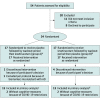Effect of Levetiracetam on Cognition in Patients With Alzheimer Disease With and Without Epileptiform Activity: A Randomized Clinical Trial
- PMID: 34570177
- PMCID: PMC8477304
- DOI: 10.1001/jamaneurol.2021.3310
Effect of Levetiracetam on Cognition in Patients With Alzheimer Disease With and Without Epileptiform Activity: A Randomized Clinical Trial
Abstract
Importance: Network hyperexcitability may contribute to cognitive dysfunction in patients with Alzheimer disease (AD).
Objective: To determine the ability of the antiseizure drug levetiracetam to improve cognition in persons with AD.
Design, setting, and participants: The Levetiracetam for Alzheimer's Disease-Associated Network Hyperexcitability (LEV-AD) study was a phase 2a randomized double-blinded placebo-controlled crossover clinical trial of 34 adults with AD that was conducted at the University of California, San Francisco, and the University of Minnesota, Twin Cities, between October 16, 2014, and July 21, 2020. Participants were adults 80 years and younger who had a Mini-Mental State Examination score of 18 points or higher and/or a Clinical Dementia Rating score of less than 2 points. Screening included overnight video electroencephalography and a 1-hour resting magnetoencephalography examination.
Interventions: Group A received placebo twice daily for 4 weeks followed by a 4-week washout period, then oral levetiracetam, 125 mg, twice daily for 4 weeks. Group B received treatment using the reverse sequence.
Main outcomes and measures: The primary outcome was the ability of levetiracetam treatment to improve executive function (measured by the National Institutes of Health Executive Abilities: Measures and Instruments for Neurobehavioral Evaluation and Research [NIH-EXAMINER] composite score). Secondary outcomes were cognition (measured by the Stroop Color and Word Test [Stroop] interference naming subscale and the Alzheimer's Disease Assessment Scale-Cognitive Subscale) and disability. Exploratory outcomes included performance on a virtual route learning test and scores on cognitive and functional tests among participants with epileptiform activity.
Results: Of 54 adults assessed for eligibility, 11 did not meet study criteria, and 9 declined to participate. A total of 34 adults (21 women [61.8%]; mean [SD] age, 62.3 [7.7] years) with AD were enrolled and randomized (17 participants to group A and 17 participants to group B). Thirteen participants (38.2%) were categorized as having epileptiform activity. In total, 28 participants (82.4%) completed the study, 10 of whom (35.7%) had epileptiform activity. Overall, treatment with levetiracetam did not change NIH-EXAMINER composite scores (mean difference vs placebo, 0.07 points; 95% CI, -0.18 to 0.32 points; P = .55) or secondary measures. However, among participants with epileptiform activity, levetiracetam treatment improved performance on the Stroop interference naming subscale (net improvement vs placebo, 7.4 points; 95% CI, 0.2-14.7 points; P = .046) and the virtual route learning test (t = 2.36; Cohen f2 = 0.11; P = .02). There were no treatment discontinuations because of adverse events.
Conclusions and relevance: In this randomized clinical trial, levetiracetam was well tolerated and, although it did not improve the primary outcome, in prespecified analysis, levetiracetam improved performance on spatial memory and executive function tasks in patients with AD and epileptiform activity. These exploratory findings warrant further assessment of antiseizure approaches in AD.
Trial registration: ClinicalTrials.gov Identifier: NCT02002819.
Conflict of interest statement
Figures


Comment in
-
Levetiracetam in Alzheimer's Disease: Do Epileptologists Already Have the Cure?Epilepsy Curr. 2022 Jul 16;22(4):225-227. doi: 10.1177/15357597221096020. eCollection 2022 Jul-Aug. Epilepsy Curr. 2022. PMID: 36187150 Free PMC article. No abstract available.
References
Publication types
MeSH terms
Substances
Associated data
Grants and funding
LinkOut - more resources
Full Text Sources
Other Literature Sources
Medical
Miscellaneous

